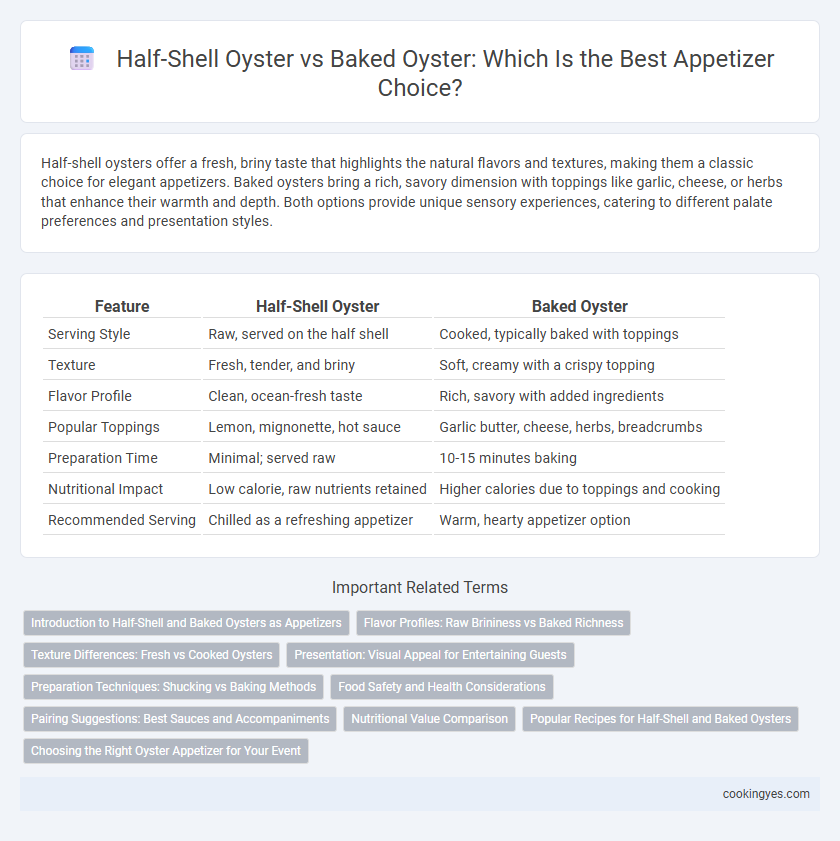Half-shell oysters offer a fresh, briny taste that highlights the natural flavors and textures, making them a classic choice for elegant appetizers. Baked oysters bring a rich, savory dimension with toppings like garlic, cheese, or herbs that enhance their warmth and depth. Both options provide unique sensory experiences, catering to different palate preferences and presentation styles.
Table of Comparison
| Feature | Half-Shell Oyster | Baked Oyster |
|---|---|---|
| Serving Style | Raw, served on the half shell | Cooked, typically baked with toppings |
| Texture | Fresh, tender, and briny | Soft, creamy with a crispy topping |
| Flavor Profile | Clean, ocean-fresh taste | Rich, savory with added ingredients |
| Popular Toppings | Lemon, mignonette, hot sauce | Garlic butter, cheese, herbs, breadcrumbs |
| Preparation Time | Minimal; served raw | 10-15 minutes baking |
| Nutritional Impact | Low calorie, raw nutrients retained | Higher calories due to toppings and cooking |
| Recommended Serving | Chilled as a refreshing appetizer | Warm, hearty appetizer option |
Introduction to Half-Shell and Baked Oysters as Appetizers
Half-shell oysters offer a fresh, briny flavor and a delicate texture, often served raw on the shell with lemon or mignonette sauce to highlight their natural taste. Baked oysters, prepared with toppings like garlic butter, cheese, or herbs, provide a warm, rich appetizer option that enhances the oyster's savory profile. Both half-shell and baked oysters remain popular choices at seafood restaurants, serving as elegant and flavorful starters.
Flavor Profiles: Raw Brininess vs Baked Richness
Half-shell oysters offer a fresh, briny flavor with a crisp, oceanic bite that highlights the natural sweetness of the sea. Baked oysters feature a rich, savory profile enhanced by buttery toppings, garlic, and cheese, creating a warm, indulgent appetizer. The contrast between the cool, saline sharpness of raw oysters and the hearty, aromatic depth of baked preparations caters to diverse palates and dining experiences.
Texture Differences: Fresh vs Cooked Oysters
Half-shell oysters deliver a crisp, briny texture with a natural, tender chew that highlights their fresh, oceanic qualities. Baked oysters transform the texture into a creamy, buttery richness with a slightly firmer bite, enhanced by toppings like garlic or cheese. The contrast between the raw smoothness of half-shell and the warm, dense finish of baked oysters defines their distinct appeal as appetizers.
Presentation: Visual Appeal for Entertaining Guests
Half-shell oysters showcase a natural, elegant presentation with their glossy, raw shells and shimmering, translucent flesh, making them a striking choice for upscale entertaining. Baked oysters offer a more robust visual appeal through golden, bubbly toppings and melted cheese, creating a warm and inviting look that complements hearty appetizers. Both presentations enhance guests' dining experience, with half-shell oysters emphasizing freshness and delicacy, while baked oysters highlight rich textures and vibrant colors.
Preparation Techniques: Shucking vs Baking Methods
Half-shell oysters require precise shucking techniques to carefully open the shell without damaging the delicate meat inside, preserving the raw, briny flavor and natural juices. In contrast, baked oysters involve cleaning and topping the shells before cooking at high heat, which enhances flavors through caramelization and infuses ingredients like garlic, cheese, or herbs. The preparation methods distinctly influence texture and taste, with shucked half-shell oysters offering a fresh, tender bite and baked oysters delivering a warm, savory experience.
Food Safety and Health Considerations
Half-shell oysters offer a fresh, raw option that requires strict sourcing from reputable suppliers to minimize risks of Vibrio bacteria and norovirus contamination. Baked oysters are cooked at high temperatures, effectively eliminating pathogens and providing a safer choice for individuals with compromised immune systems or pregnant women. Choosing baked oysters reduces the risk of foodborne illnesses while maintaining essential nutrients, making them a health-conscious appetizer option.
Pairing Suggestions: Best Sauces and Accompaniments
Half-shell oysters pair exceptionally well with classic mignonette sauce, fresh lemon wedges, and a touch of horseradish, enhancing their briny and delicate flavors. Baked oysters, often richer due to toppings like garlic butter, cheese, or breadcrumbs, complement creamy aioli, tangy cocktail sauce, or a smoky chipotle mayo to balance their savory depth. Serving both with crisp white wines like Sauvignon Blanc or sparkling Champagne elevates the tasting experience by cutting through the oysters' richness.
Nutritional Value Comparison
Half-shell oysters provide a rich source of zinc, low calories, and high levels of omega-3 fatty acids, making them a nutrient-dense option for appetizers. Baked oysters, while slightly higher in calories due to added toppings and cooking methods, retain protein and essential minerals but may contain increased sodium levels. Choosing between half-shell or baked oysters depends on nutritional priorities such as calorie control or flavor enhancement without compromising key vitamins and minerals.
Popular Recipes for Half-Shell and Baked Oysters
Half-shell oysters offer a fresh, briny flavor ideal for classic preparations like raw oysters on the half shell with mignonette or cocktail sauce, making them a popular choice for elegant appetizers. Baked oysters, such as Oysters Rockefeller with spinach and breadcrumbs or Parmesan-crusted oysters, provide a warm, savory option that highlights rich toppings and melted cheese. Both half-shell and baked oyster recipes remain favorites in seafood menus for their distinct textures and customizable flavors.
Choosing the Right Oyster Appetizer for Your Event
Half-shell oysters offer a fresh, briny flavor and elegant presentation ideal for upscale events and seafood enthusiasts seeking a light, natural taste. Baked oysters provide a warm, rich option with customizable toppings like garlic butter, cheese, or herbs, making them perfect for cozy, casual gatherings or guests preferring cooked dishes. Selecting the right oyster appetizer depends on event style, guest preferences, and desired flavor profiles to ensure a memorable seafood experience.
Half-shell oyster vs baked oyster for appetizers Infographic

 cookingyes.com
cookingyes.com